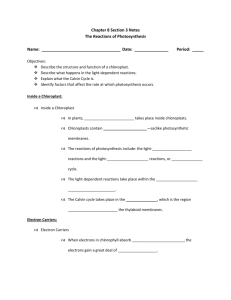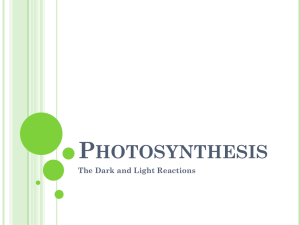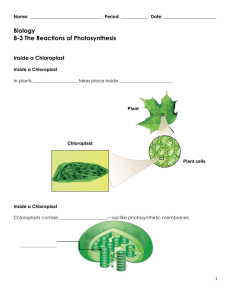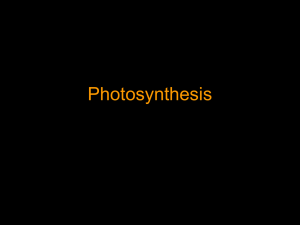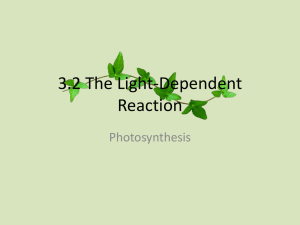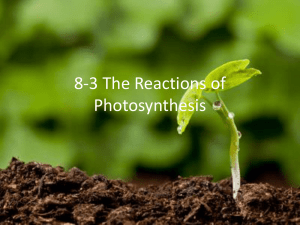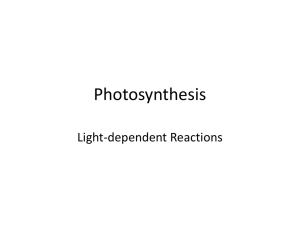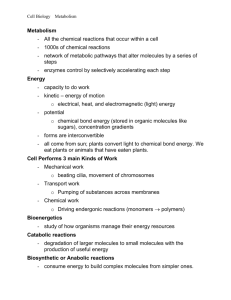8-3 The Reactions of Photosynthesis In plants, photosynthesis takes
advertisement
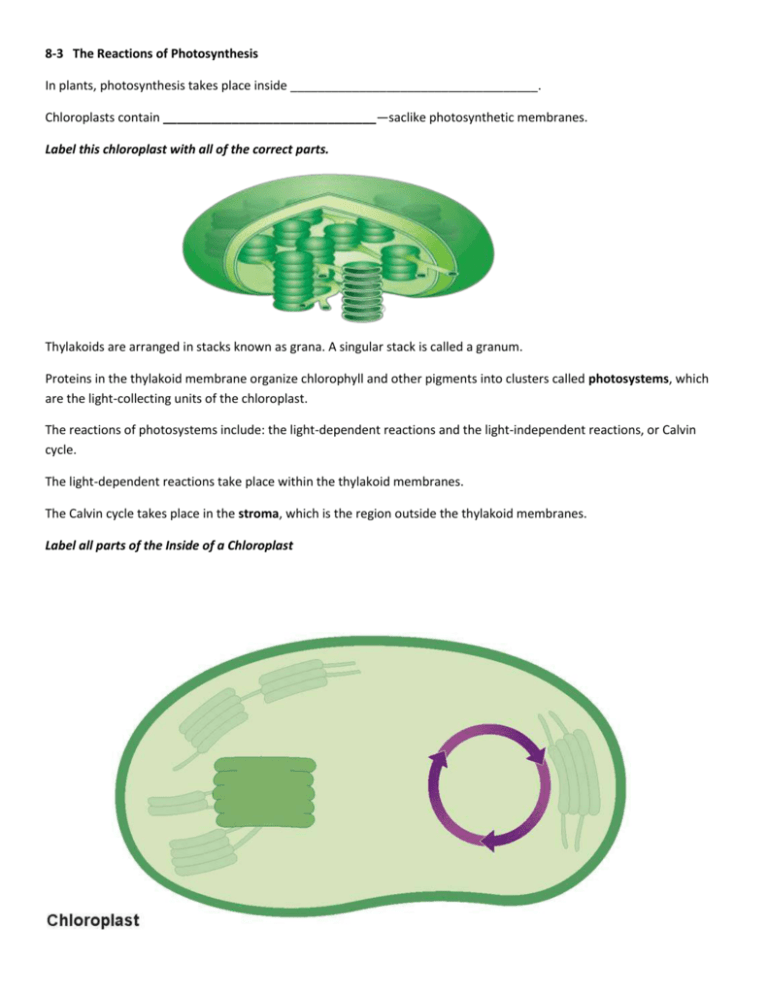
8-3 The Reactions of Photosynthesis In plants, photosynthesis takes place inside ____________________________________. Chloroplasts contain _______________________________—saclike photosynthetic membranes. Label this chloroplast with all of the correct parts. Thylakoids are arranged in stacks known as grana. A singular stack is called a granum. Proteins in the thylakoid membrane organize chlorophyll and other pigments into clusters called photosystems, which are the light-collecting units of the chloroplast. The reactions of photosystems include: the light-dependent reactions and the light-independent reactions, or Calvin cycle. The light-dependent reactions take place within the thylakoid membranes. The Calvin cycle takes place in the stroma, which is the region outside the thylakoid membranes. Label all parts of the Inside of a Chloroplast Electron Carriers When electrons in chlorophyll absorb ____________________, the electrons gain a great deal of __________________. Cells use ____________________________________ to transport these high-energy electrons from chlorophyll to other molecules. One carrier molecule is ____________________. Electron carriers, such as NADP+, transport ______________________. NADP+ accepts and holds 2 high-energy electrons along with a hydrogen ion (H+). This converts the NADP+ into _______________. The conversion of NADP+ into NADPH is one way some of the energy of _________________________ can be trapped in __________________________ form. The NADPH carries high-energy electrons to ______________________________________ elsewhere in the cell. These high-energy electrons are used to help build a variety of molecules the cell needs, including ____________________________________ like _________________________________. Light-Dependent Reactions The light-dependent reactions require _____________________________. The light-dependent reactions produce ___________________________ gas and convert ADP and NADP+ into the energy carriers ________________ and ________________________. Label the diagram of Light-Dependent Reactions. The specific steps of the Light-Dependent Reactions follow in order after the diagram. 1. Photosynthesis begins when pigments in photosystem II absorb light, increasing their energy level. 2. These high-energy electrons are passed on to the electron transport chain. 3. Enzymes on the thylakoid membrane break water molecules into: hydrogen ions, oxygen atoms, energized electrons 4. The energized electrons from water replace the high-energy electrons that chlorophyll lost to the electron transport chain. 5. As plants remove electrons from water, oxygen is left behind and is released into the air. 6. The hydrogen ions left behind when water is broken apart are released inside the thylakoid membrane. 7. Energy from the electrons is used to transport H+ ions from the stroma into the inner thylakoid space. 8. High-energy electrons move through the electron transport chain from photosystem II to photosystem I. 9. Pigments in photosystem I use energy from light to re-energize the electrons. 10. NADP+ then picks up these high-energy electrons, along with H+ ions, and becomes NADPH. 11. As electrons are passed from chlorophyll to NADP+, more H+ ions are pumped across the membrane. 12. Soon, the inside of the membrane fills up with positively charged hydrogen ions, which makes the outside of the membrane negatively charged. 13. The difference in charges across the membrane provides the energy to make ATP. 14. H+ ions cannot cross the membrane directly. 15. The cell membrane contains a protein called ATP synthase that allows H+ ions to pass through it. 16. As H+ ions pass through ATP synthase, the protein rotates. 17. As it rotates, ATP synthase binds ADP and a phosphate group together to produce ATP. 18. Because of this system, light-dependent electron transport produces not only high-energy electrons but ATP as well. The light-dependent reactions use __________________________________________________________________. The light-dependent reactions produce ______________________________________________________________. These compounds provide the energy to __________________ energy-containing sugars from low-energy compounds. The Calvin Cycle ATP and NADPH formed by the light-dependent reactions contain an abundance of chemical energy, but they are not _________________________ enough to store that energy for more than a few minutes. During the __________________________________ plants use the energy that ATP and NADPH contain to build highenergy compounds that can be stored for a long time. The Calvin cycle uses ATP and NADPH from the light-dependent reactions to produce _____________________________________. Because the Calvin cycle does not require light, these reactions are also called the light-independent reactions. 1. 2. 3. 4. 5. Six carbon dioxide molecules enter the cycle from the atmosphere and combine with six 5-carbon molecules. The result is twelve 3-carbon molecules, which are then converted into higher-energy forms. The energy for this conversion comes from ATP and high-energy electrons from NADPH. Two of twelve 3-carbon molecules are removed from the cycle. The molecules are used to produce sugars, lipids, amino acids and other compounds. 6. The 10 remaining 3-carbon molecules are converted back into six 5-carbon molecules, which are used to begin the next cycle. Use this space to draw The Calvin Cycle. Be sure to label all of the parts. The two sets of photosynthetic reactions work together. • The light-dependent reactions trap sunlight energy in chemical form. • The light-independent reactions use that chemical energy to produce stable, highenergy sugars from carbon dioxide and water. Factors Affecting Photosynthesis Many factors affect the rate of photosynthesis, including: • Water • Temperature • Intensity of light
